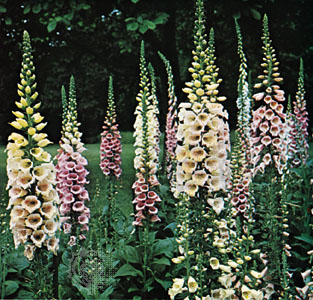Foxgloves for Vertical Beauty and Historic Interest
By Sharon V. Smith, Fairfax Master Gardener Intern
 Who doesn’t know and appreciate foxgloves, those beloved plants with majestic spikes of flowers standing tall for all to see. But you may not know that the beautiful Digitalis purpurea plant, a member of the Plantain family, has many other names besides foxglove, such as dead man’s bells, fairies’ glove, and witches’ thimble, to name a few. A look into the plant’s history suggests why.
Who doesn’t know and appreciate foxgloves, those beloved plants with majestic spikes of flowers standing tall for all to see. But you may not know that the beautiful Digitalis purpurea plant, a member of the Plantain family, has many other names besides foxglove, such as dead man’s bells, fairies’ glove, and witches’ thimble, to name a few. A look into the plant’s history suggests why.
In 1542, Leonhart Fuchs, a Bavarian physician and one of the founders of modern biology, named the wildflower, digitalis. He was inspired by the German word, fingerhut (thimble), referring to the flowers’ shape, which explains why “glove” is part of the name. It is up for debate as to where “fox” originated. Nevertheless, it is interesting to note that the last name, Fuchs, when translated into English, is fox.
At one time, foxglove was called “folksglove.” Some believe it is in reference to fairies, which are referred to as “the good folks.” Yet as time went by, the first part of the name changed to fox from folks, and today etymologists continue to debate the point as to why.
As a native wildflower of Europe and Northern Africa, foxgloves love to grow in rich soil at the edge of woodlands or other semi-shaded spots. Given the right environment in our gardens – semi-shaded locations with moist, well-drained soil that is acidic-to-nearly-neutral (pH 6.5 optimal) — foxgloves can reach their fullest height of 5 to 6 feet tall. When planted in sun, they generally will reach 4 feet tall. For the best outcome, foxgloves prefer morning sun and afternoon shade during the hottest part of the day. Plants receiving the afternoon sun will tend to decline.
 One way to use foxgloves in your landscape is as a back anchor and border to garden beds. Planting them en masse in woodland or cottage gardens also makes a wonderful visual statement. They bloom from a broad rosette in late spring to early summer on tall, almost leafless flower spikes. Since foxgloves are biennials, you will only see the flowers in the second year. The first year, the plant is developing healthy roots and leaves that will overwinter as evergreen foliage.
One way to use foxgloves in your landscape is as a back anchor and border to garden beds. Planting them en masse in woodland or cottage gardens also makes a wonderful visual statement. They bloom from a broad rosette in late spring to early summer on tall, almost leafless flower spikes. Since foxgloves are biennials, you will only see the flowers in the second year. The first year, the plant is developing healthy roots and leaves that will overwinter as evergreen foliage.
Since foxgloves self-sow, it is important to let the flowers dry on the stalk. The foxglove fruit is a capsule. Once mature, it will split open, releasing many tiny seeds. To encourage regrowth, make sure the soil does not dry out or get too soggy when seeds drop. If using as cut flowers, cut the stalk down to the basal foliage to encourage regrowth. Keep in mind you may decrease your reseeding yield, yet the plant may send up another stalk, delighting its gardener with a second bloom.
The best time to plant the foxglove seeds is in spring after threat of frost has passed, and the best method is surface sowing, which means scattering the seeds on top of the soil. The seeds need light to germinate; therefore, any buried seed will fail to develop. Gently rake in the seeds; then water 1 to 2 inches deep, making sure the soil does not dry out.

Pam’s Choice
Foxgloves are deer resistant. Because the plant is poisonous, deer avoid it. We should take note of that as well since ingesting any part of the plant including seeds, leaves and flowers could be deadly for us, too. Since it tastes very bitter, wildlife and humans naturally resist. Wear gloves when handling the plant, and do not plant it where pets and children like to play and roam. Foxgloves are the perfect pollinator plant and will provide much enjoyment to bees, butterflies, hummingbirds and gardeners alike.

Excelsior Mix
Depending on what 18th century historical article you may read, you will find that Mother Hutton, a British pharmacist/herbalist, was the first to discover the medicinal usages of foxgloves and became known in 1766 when she successfully treated Dr. Ralph Cawley, President of Brazen Nose College (known today as Brasenose College) of Oxford University for dropsy (edema). Much of the discovery credit, though, is given to William Withering, an English physician. He carefully compiled 163 case studies over a 10-year period in An Account of the Foxglove, a 207-page book published in 1785.
Medical treatments in use today have origins in this early research. A common drug made from digitalis is Digoxin (Lanoxin), prescribed to treat congestive heart failure and atrial fibrillation. This is just one reason why we love our foxgloves. The other reason could just be simply how stately and beautiful these flowers look growing in our gardens.
Resources
• The Plantain Family, Fulton-Montgomery Community College
• 1000 Gardening Questions and Answers based on the “Garden Q & A”, The New York Times, with
additional material by Leslie Land
• Profiles in Cardiology, William Withering and An Account of The Foxglove, M.E. Silverman, M. D., Department
of Medicine, Emory University School of Medicine